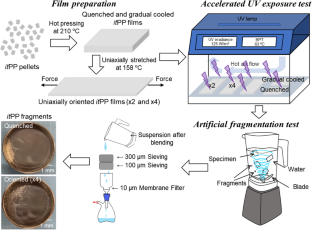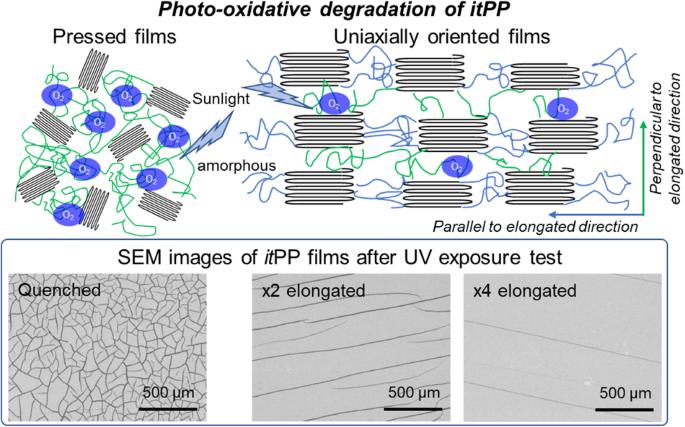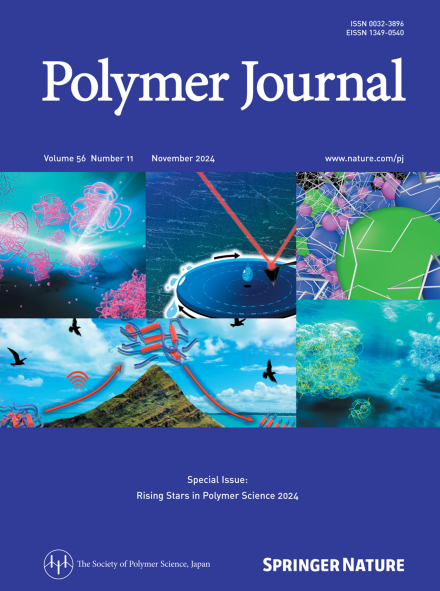Photooxidative degradation and fragmentation behaviors of oriented isotactic polypropylene
IF 2.3
4区 化学
Q3 POLYMER SCIENCE
引用次数: 0
Abstract
The photooxidative degradation and fragmentation behaviors of isotactic polypropylene (itPP) were simulated in laboratory after various postconditions, such as quenching, gradual cooling and drawing, using an artificial weathering machine and a blender. The crystallinity of the itPP films and orientation of the molecular chains play important roles in the photooxidation of the itPP films. Compared to quenched itPP films with the same ultraviolet (UV) exposure time, highly oriented itPP films and gradually cooled itPP films with higher crystallinity exhibited a lower rate of photooxidative degradation. To clarify the photooxidative degradation mechanism, the surface morphology, chemical structure, and microstructure of the UV-exposed itPP films were investigated using scanning electron microscopy, infrared spectroscopy, differential scanning calorimetry, and wide- and small-angle X-ray scattering. Photooxidative degradation was inhibited as the orientation degree of the itPP film increased. These results indicate that photooxidation likely occurs in the amorphous phase of itPP. Oriented molecular chains effectively slowed the photooxidative degradation of the itPP films. The artificial fragmentation test of UV-exposed itPP films showed that itPP films with lower crystallinity and orientation degrees were crushed into microplastics that were much smaller in size than those with higher crystallinity or orientation degrees. Photooxidation and fragmentation behaviors of itPP were studied. Photooxidation likely occurred in the amorphous regions of itPP due to the higher oxygen diffusion. Surface deterioration was observed on the UV-exposed itPP films. Pressed films exhibited much denser cracks compared to uniaxially oriented itPP films. Notably, cracks in the uniaxially oriented itPP films were formed along the direction of orientation and decreased with increasing draw ratio. The crystalline structure and oriented molecular chains notably inhibited the photooxidative degradation and fragmentation of the itPP films.


拉伸异策聚丙烯的光氧化降解和碎裂行为
在实验室中,利用人工老化机和搅拌机模拟了异策聚丙烯(itPP)在淬火、逐渐冷却和拉伸等不同后处理条件下的光氧化降解和破碎行为。itPP 薄膜的结晶度和分子链的取向对 itPP 薄膜的光氧化起着重要作用。与紫外线(UV)照射时间相同的淬火 itPP 薄膜相比,高取向 itPP 薄膜和结晶度较高的逐渐冷却 itPP 薄膜的光氧化降解率较低。为了阐明光氧化降解机理,研究人员使用扫描电子显微镜、红外光谱、差示扫描量热仪、广角和小角 X 射线散射法研究了紫外线暴露 itPP 薄膜的表面形貌、化学结构和微观结构。随着 itPP 薄膜取向度的增加,光氧化降解受到抑制。这些结果表明,光氧化很可能发生在 itPP 的无定形相中。取向分子链有效地减缓了 itPP 薄膜的光氧化降解。对暴露在紫外线下的 itPP 薄膜进行的人工破碎测试表明,结晶度和取向度较低的 itPP 薄膜被破碎成的微塑料比结晶度或取向度较高的薄膜小得多。
本文章由计算机程序翻译,如有差异,请以英文原文为准。
求助全文
约1分钟内获得全文
求助全文
来源期刊

Polymer Journal
化学-高分子科学
CiteScore
5.60
自引率
7.10%
发文量
131
审稿时长
2.5 months
期刊介绍:
Polymer Journal promotes research from all aspects of polymer science from anywhere in the world and aims to provide an integrated platform for scientific communication that assists the advancement of polymer science and related fields. The journal publishes Original Articles, Notes, Short Communications and Reviews.
Subject areas and topics of particular interest within the journal''s scope include, but are not limited to, those listed below:
Polymer synthesis and reactions
Polymer structures
Physical properties of polymers
Polymer surface and interfaces
Functional polymers
Supramolecular polymers
Self-assembled materials
Biopolymers and bio-related polymer materials
Polymer engineering.
 求助内容:
求助内容: 应助结果提醒方式:
应助结果提醒方式:


